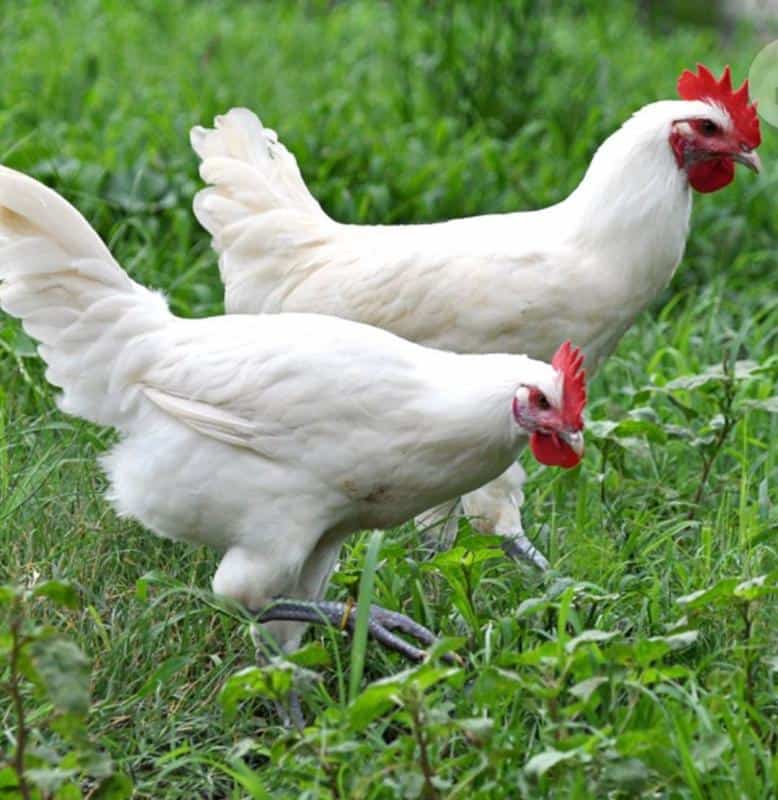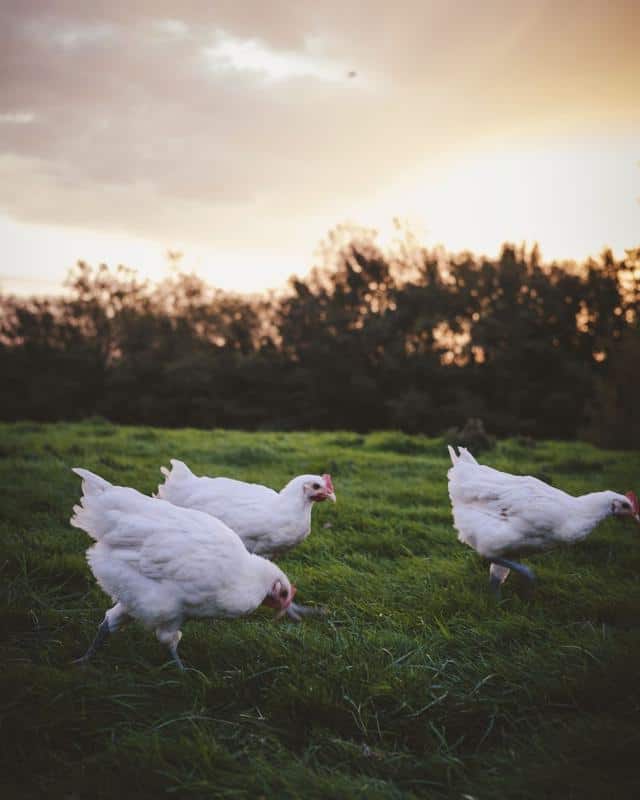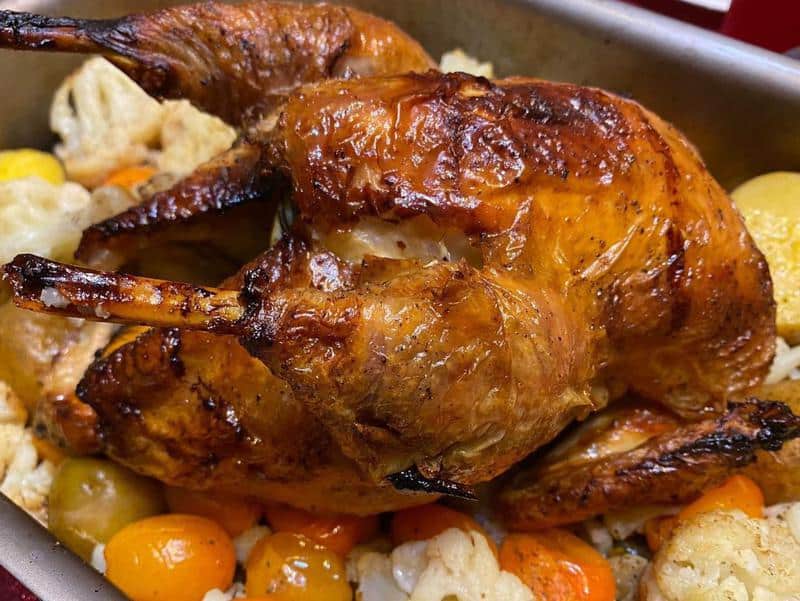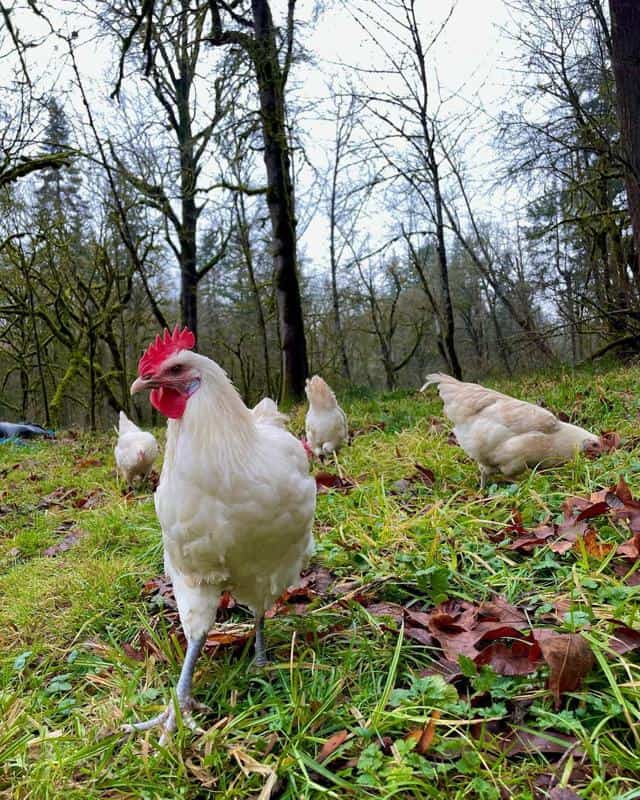Grab your device, and on your favorite browser, search for “the tastiest chicken breed”. If there’s one chicken reigning supreme on your Google search engine result pages, it has to be the Bresse chicken — and they’re just that!
The Bresse, usually pronounced as a single syllable word without the “e” at the end, also known as Bresse Gauloise, is widely considered the most delectable chicken species on the planet, making it one of the highly esteemed table birds among culinary professionals.

But hey, there’s so much more exciting about these adorable feathered friends than just their scrumptious flesh!
Get ready as we begin our delightful adventure into the world of the Bresse chicken breed. In this coverage, we leave no stone unturned, so join us to discover all the mysteries and intricacies of this French chicken breed.
Bresse Chicken Quick Fact:
Before diving into the inside details of the Bresse chickens, we’ve captured the breed’s characteristics and put them on this table.
| The Bresse Chicken Breed Overview | |
| Origin | Bresse province, France |
| Chicken size | Medium |
| Color of feathers | Mostly pure white, but pure blue, gray, splash, and black variants are also available. |
| Comb type | Single – stiff in roosters, drooping in hens |
| Color of comb and wattles | Bright red |
| Earlobe color | White |
| Skin color | White |
| Disposition | Docile, social, and super-curious |
| Dual-Purpose | Yes |
| Feet type | Clean |
| Feet color | Blue |
| Number of eggs per year | 250 to 300 |
| Size of eggs | Medium |
| Egg color | Cream |
| Weather-hardy | Yes |
Origin and Production of the Bresse Chicken
The Bresse chicken has been around for about 500 years. It was first bred in the eastern region of France, a province called “Bresse”, which is where the breed acquired the name.
Unlike most backyard birds, Bresse chickens are a protected bird. You see, usually, once a chicken breed has been developed, it can be replicated in any other region in the world as long as the breeding is done using the correct breeding techniques.
But that’s not the case with the Bresse chickens.
Instead, Bresse chickens are developed and raised under strict controls, which include keeping them within the legally defined area, the “Bresse” province, a rectangular piece of land that measures approximately 60 by 25 miles.
In Bresse, there are about 200 breeders of this chicken breed, and each of them is expected to have at least 0.5 hectares of production area as part of the stipulation, as each bird needs at least 10m2 of space when growing.
The Bresse region is believed to offer the ideal conditions for raising authentic Bresses, thanks to the uniqueness of the terrain and the locally-grown feed supplements available to the chickens as they go about their free-ranging and foraging endeavors.
Once raised, each bird has to pass through the Centre de Sélection de la Volaille de Bresse, the only breeding center for these chickens, for inspection.
Birds that meet the set standards are conferred the title “ Poulet de Bresse”, which basically means that the chicken is bred in Bresse, allowed to eat local food, and raised within that area with strict adherence to the set feeding guidelines.
However, that’s not to say you can’t find Bresse chickens outside France. You can, in fact, but they’re just an uncommon sight to catch outside of their native country.
Plus, the fact that you spot one elsewhere means it definitely isn’t the revered “Poulet de Bresse”, as one of the requirements for retaining this title is that the bird has to exclusively be within the boundaries of France.
Outside the defined rearing area, Bresse chickens adopt other titles like La Gauloise, Bresse-Gauloise, or even American Bresse Chicken, depending on the area they’re found in. These names help set them apart from the authentic Poulet de Bresse.
The Breed Size
When talking about the size of Bresse chickens, it’s no exceptional from that of most other breeds. The males weigh more when fully mature, attaining about 7.5 pounds, while the females can typically grow up to 6.5 pounds.
But then, it’s worth noting that individual weight differences are still possible within the breed, meaning that some chickens can weigh much less or more than the bird’s standard weight.
Bresse Chicken Appearance

Bresse chickens, both roos and hens, have a single bright red comb and wattles beneath it. However, some slight differences exist on the size of the combs and how they’re erected depending on whether the chicken is male or female.
For males, the combs are stiff and larger, exceeding the norm you might expect. That’s different from what you see in females — average-sized combs with a slightly drooping orientation.
The legs are clean without any feathers, just like with most chickens. However, one noticeable characteristic is that they’re blue in color, making the breed stand out from most other breeds.
As for the color of feathers, Bresse chickens are available in pure white, blue, splash, gray, or black colors. The white variant, locally referred to as the Bresse de Bény variety, is the most common of the 5 and, in fact, the only color from which Poulet de Bresse may be produced.
But there’s no significant difference between the color varieties of the Bresse chicken. Apart from the feathers’ color and the privilege to enjoy the revered title, white-colored Bresse chickens don’t differ from other color varieties in any other way as long as the birds are reared under the same conditions.
Also Read: Best White Chicken Breeds
Chicken Disposition
Generally, the Bresse chickens have an excellent personality, making them a good go-to breed for the average backyard chicken keeper.
They’re gentle, docile, and social, although preferring the company of other feathered flock members more than their human companions. Some can still make great pets, but if you want more of a pet than anything else in your chicken, they definitely aren’t among the breeds you should look at.
Bresse chickens are also super-curious, exhibiting immense energy to explore what’s in their surrounding. This curiosity comes with an instinctive foraging behavior, often preferring to find their own food, although not neglecting what you’re ready to offer them.
Bresse birds are also alert. That’s a good attribute, especially if you’re living in an area with a large population of chicken predators, as this keen awareness lets them notice any potential threat as soon as it emerges, providing them with enough time to elude the intruder.
Meat Production

If there’s one area for which the Bresse chickens are known for, then it’s meat production. These chickens promise pure delight to our taste buds, thanks to their upbringing and the unique genetic anomaly that gives them a metabolism different from that of any other chicken.
As birds for the table, Bresse chickens are too good that they even bear a cute name, “Queen of chickens”, a title that perfectly captures their culinary supremacy and unmatched excellence at the dinner table.
The birds are ready for slaughter from 4 months if hens, but that may be delayed until 8 months for capons. By this time, they’ve matured and even developed extra fat from the closely regulated diet they receive at their “finishing” stage in confinement.
It’s also worth noting that the Bresse chickens have thin and dainty bones. This means that they have a larger meat-to-bone ratio than most chickens, providing more room over the skeleton for growing more meat.
Egg Production

While they are popular for the outstanding quality of their meat, Bresse chickens aren’t a one-tricky-pony chicken equivalent. They excel in egg production, making them a godsend option for any chicken enthusiast looking for a prolific layer that can also serve as a bird for the table.
The bird can attain an astounding egg count of 250, so you can rely on them if you want a chicken breed that will help keep your egg cartons replenished. We’ve even had instances where some of the breed keepers get about 300 eggs per year, but this could be part of the subtle variations within the breed.
The eggs are usually average in size, weighing 45 to 55 grams. However, when starting the egg-laying journey, the eggs are usually smaller in size before gradually growing into the standard size, just as with almost every other chicken that lays eggs.
Even more, these chickens seldom go broody and are weather-hardy. That means their egg production won’t diminish or stop when the cold months of winter roll around, ensuring you get a regular supply of eggs all year round.
The egg production starts at 16 weeks, but don’t be surprised if your bird begins it after turning 14 weeks. The eggs are usually cream-colored, although this may again differ depending on environmental factors.
Feeding Requirements
While Bresse chickens can be fed just like any other breed, they have a unique feeding plan you should follow if you intend to maintain the bird’s supremacy at providing tasty meat.
In their native country, Bresse chickens are fed dairy as chicks. Once they reach the age of 35 days, they’re given cereals and dairy, intentionally keeping the diet low in proteins to allow them to forage for insects within the terrain.
They’re then fattened in an épinette, which basically is a cage placed in a fattening shed. There, the chickens are intensively fed dairy and corn. That goes on for 2 weeks if pullets and up to 4 weeks for the larger hens before they’re slaughtered with a minimum weight of 1.2 kgs and 1.8 kgs, respectively.
As for the capons, fattening happens for about 4 weeks before they’re slaughtered at 8 months old when they’re about 3 kgs.
Habitat
Before you consider getting a Bresse chicken, be ready to mimic the nature of housing offered in their native land. They do well in large and small flocks but ensure you have a large piece of land where they can forage for insects and other essential food sources.
Of course, you also have to keep their coop clean to minimize the chances of disease and keep them happy.
Read More:
FAQS
What Is Special About Bresse Chicken?
Bresse chickens have outstanding meat quality thanks to their special genetic anomaly promoting marbling, a quality extremely rare in the poultry world. Marbling is whereby fat deposits spread throughout a cut of meat, giving the bird a flavor that stands out from that of any other chicken.
Why Is Bresse Chicken So Expensive?
Bresse chickens are expensive because they’re extremely rare to find and must be raised under very strict dietary and environmental guidelines. Generally, rearing these chickens is more expensive than the standard procedure for other breeds.
Where Can I Get Bresse Chicks?
Due to their limited distribution and protected status, Bresse chicks aren’t the kind you’ll find in your local hatcheries, especially if you’re outside France.
Instead, you can get these chicks from international breeders or importers. You may also want to use social groups and forums to find chicken enthusiasts who occasionally have these chicks for sale.
Conclusion
Bresse chickens are a popular meat bird with high prowess in laying eggs. The chickens exhibit a high degree of weather hardiness but have a protected status that restricts their authenticity when reared in any other area of the world apart from the officially designated area, Bresse in France.
Unlike normal chickens, Bresse birds have stringent dietary guidelines, mostly comprising milk and cereals. Their unique genetic anomaly gives them a distinctive metabolism, giving their meat a taste that stands out at the dinner table.
